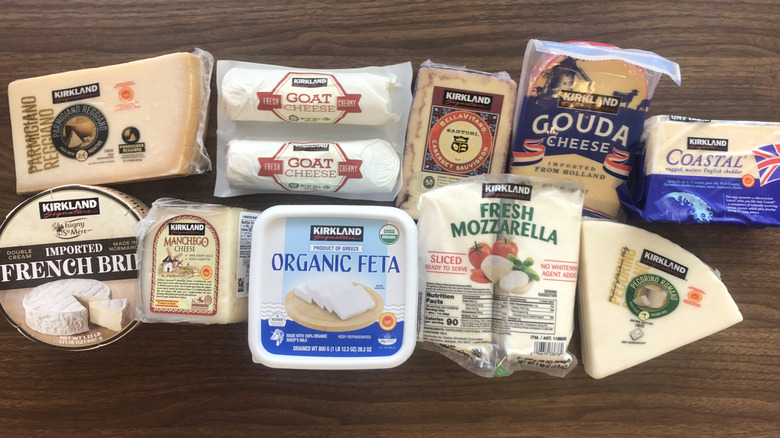
Megan Hageman / Tasting Table
There’s nothing better than a finely-made, artisanal cheese. Stacked onto an irresistibly vibrant grazing board, it’s one of life’s little luxuries — and, more importantly, a little luxury that doesn’t have to break the bank. Not all fancy cheese comes with a fancy price tag. You can find everything you need at a store like Costco, for a fraction of the price and in bulk sizes large enough to turn every night into a wine and cheese night. More cheese for your buck? Yes, please. They had me at cheese, and I had to see for myself which wheels and wedges are worthy of a spot in the ol’ Costco mega cart.
The membership club is oozing with a wide variety of cheesy picks just under the Kirkland Signature umbrella alone. And I’m not talking about everyday shredded blends for pizza or individual slices for sandwiches. I’m talking about aged Manchegos, Pecorino Romanos straight from Italy, and imported French bries. It’s a global cheese odyssey plopped right in the heart of Costco’s refrigerator section.
Recently, I embarked on this world tour to pick up 10 different gourmet-style Kirkland Signature cheeses. After leaving the warehouse with what seemed like a lifetime supply of the good stuff, I got to tasting. Pairing each one with a simple cracker, I ranked each selection by origin, age, bouquet, texture, and flavor profile. I know what you’re thinking, “Is that it?” But it takes a lot to make a great cheese, and this careful process helped me uncover the very best Costco fromages that would have any cheesemonger reaching for their membership card.
10. Kirkland Signature Fresh Mozzarella
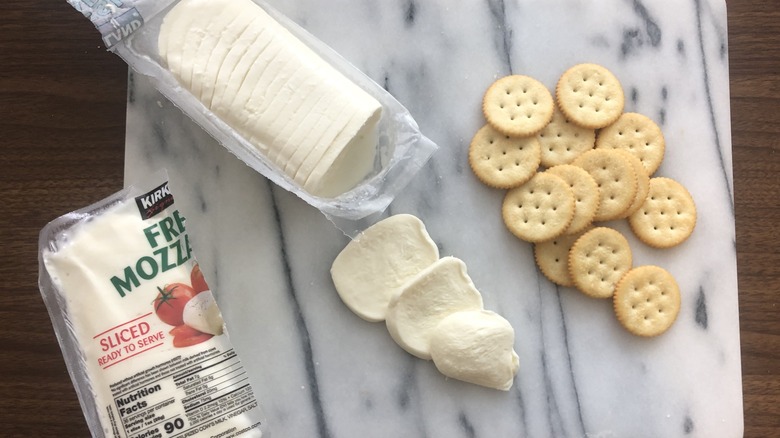
Megan Hageman / Tasting Table
I know. I know. A Ritz cracker is an incongruous vessel for a fresh slice of mozzarella. Behind the scenes, I also teamed it up with a few spare cherry tomatoes and a drizzle of extra virgin olive oil for a makeshift caprese salad (minus the basil). Honestly, though, simply eating this Kirkland cheese pure without any accompaniments told me everything I needed to know.
It looks like your average mozzarella log, similar to one you would find branded with the BelGioioso or Galbani logo. It tears and feels just like your average mozzarella with a decent spring. But it tastes like nothing at all. Beyond a subtle milkiness, I couldn’t detect a single tang or salty grain. Even a plain ol’ mozzarella string cheese stick has more oomph. It also runs dry compared to other brands out there, like not enough juice was left in the cylindrical package. All this is to say that it doesn’t do enough to jump any of the other Kirkland cheeses.
On a positive note, it’s still a versatile and functional refrigerator staple — and one that you won’t run out of any time soon thanks to Costco’s supersized dual packaging. It comes pre-sliced, so you can throw it onto a margherita pizza or a bubbling baked ziti without missing a beat. Alternatively, if you’re not going the baking route, it would make for a great textural add-in for a fresh salad. Its hardly noticeable flavor is bound to go well with anything you choose.
9. Kirkland Signature Organic Feta
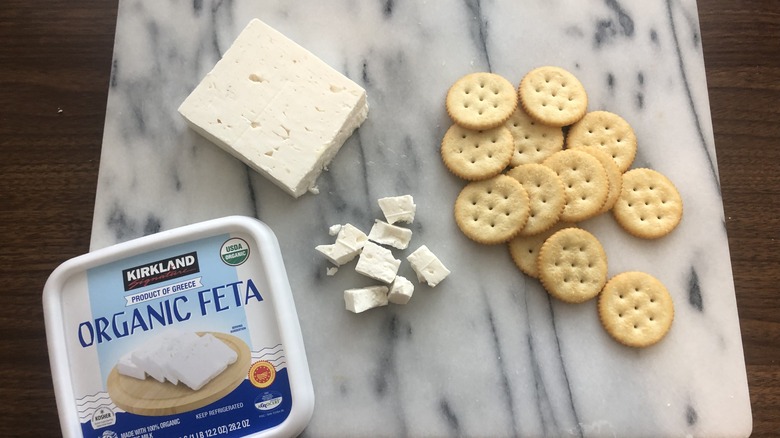
Megan Hageman / Tasting Table
I can’t put my finger on why this feta cheese tastes so different from others I typically buy. And, when I say “different”, I don’t necessarily mean it in a good way. If I’m buying feta, I’m picking up the President brand feta crumbles (you know, the blue tubs with the shake-friendly lids?) It’s perhaps not the most authentic, though, it gets the job done with a salty tang and classic Mediterranean flavor. The Kirkland organic feta does not breed the same results.
Four total slabs of cheese sit in the square, juice-filled container. They fit the part appearance-wise and even crumble as they should — I would even say exceptionally well after a quick rinse to firm it up. It’s the effect on the taste buds that doesn’t quite do it for me. It dials up the brine while dialing down all other flavors. It’s then squeaky on the outside, and dry at its core.
This was surprising, considering the product seemed to set itself up for success. It is, in fact, a product of Greece and is made with 100% organic sheep’s milk. In terms of US regulations, it’s also classified as USDA organic. Even with these selling points, it still barely jumps the mozzarella in taste. On the bright side, though, after you’re through all your cheese, this leftover tub would make for an excellent container for sidewalk chalk or other crafts. So, I suppose all is not lost.
8. Kirkland Signature Imported French Brie
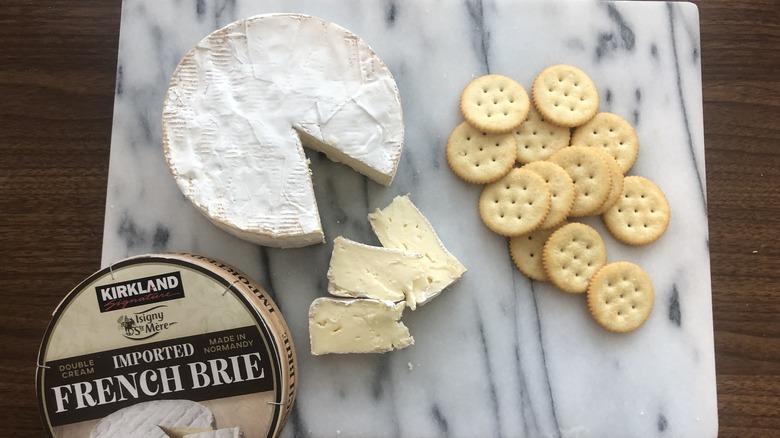
Megan Hageman / Tasting Table
I love a great brie. And the sheer size of Kirkland’s wheel alone (this thing weighs 1.32 pounds!) had me dreaming of endless fruit pairings, puff pastries, and a mouthwatering baked brie dish smothered in honey and walnuts. Clearly, I had high hopes for this Normandy-made imported French brie, and unfortunately, it did let me down to some extent.
Let me preface this by saying this cheese does admit to changing over time. The packaging shares that when it’s younger, it will be milder and firmer. Then, as it starts to approach its sell-by date, it will continually become more buttery, creamy, and robust. I specifically sought out a round that was further along in this process to get in on some of those finale notes. By the time I tasted it, it was less than 10 days from its sell-by date, yet it still tasted like a young brie. Despite promises of double cream, it’s mildly creamy at best, even at room temperature–closer to a Play-Doh consistency than a creamy, spreadable cheese. It has a bit of salt and that familiar earthy bite, but luxurious buttery notes are also lacking.
For me, it’s not a product that feeds into my brie love affair. It’s just a decent brie at an affordable price. Within Kirkland’s cheese lineup, it only rises above the brand’s strange feta and bland mozzarella, falling short of the extra creamy, extra rich decadence I would expect from a true French brie.
7. Kirkland Signature Italian Parmigiano Reggiano
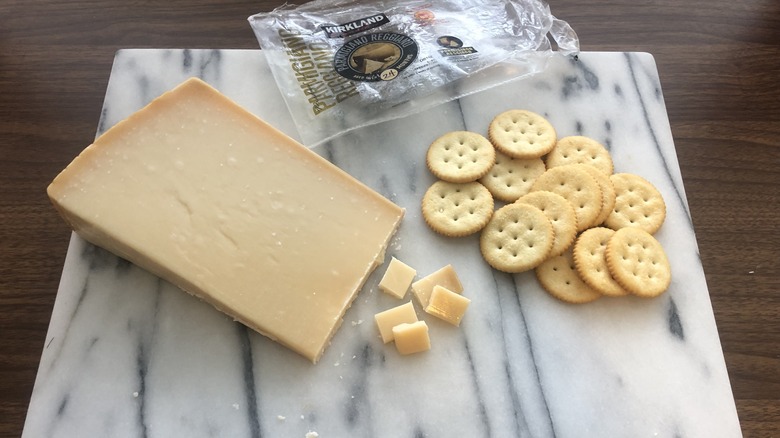
Megan Hageman / Tasting Table
The Kirkland Parmigiano Reggiano is a chip off the old block … literally. Each wedge is carved from a wheel in Italy that abides by the country’s strict maturation standards and traditions, so it is PDO (Protected Designation of Origin) certified. Aged for over 24 months, it’s not quite a Stravecchio, but it is considered more mature and complex than a young Parmigiano.
I’ve had better Parmigianos, and I’ve had worse. This one lands somewhere in the middle. It has that dry Parmesan character that zaps the moisture from your mouth like the tannins in wine. The hard, crumbly texture is accompanied by a crunchiness brought to you by intermittent tyrosine crystals. Where I think it could improve is by bringing more of that bold flavor to the forefront. It’s salty throughout, though much of the sharpness and notes of umami and nuttiness don’t come until the very end of the bite or even into the aftertaste. In a few pieces, I did get an almost blue cheese-like tang and pungency, and I wish that had been more widely available.
For the most expensive cheese on the list, I expected a greater wow factor. Still, I will gladly use up the rest of my 1½-pound hunk. I know the most common use would be to grate it over a pasta or salad. But Parmesan is also one of my favorite munching cheeses. I love those sharp, salty bites, especially paired with a savory salami, and I’d still reach for the Kirkland wedge for that purpose, even with its milder profile.
6. Kirkland Signature Gouda
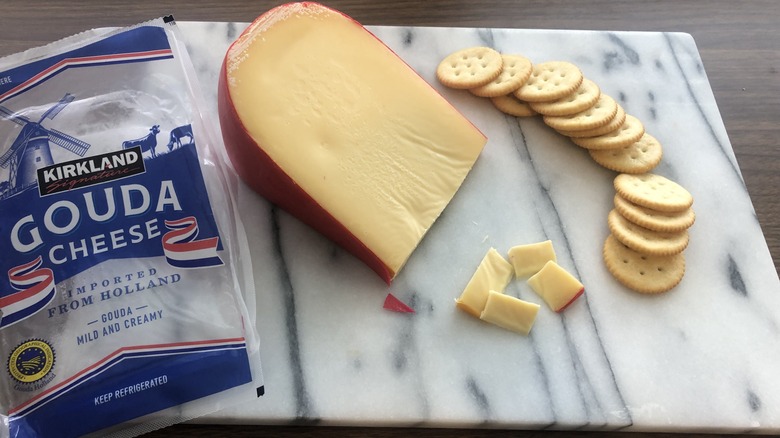
Megan Hageman / Tasting Table
This Gouda is pretty good-a. I’m sorry, I had to. That’s my one and only cheesy joke, I swear. The Kirkland Signature Gouda blocks come straight from the source in Holland. It has the stamp to prove its authentic origin, just as many of Costco’s other cheeses do. If you’ve bought Gouda before, you know this is a very classic look for the cheese: a yellowed tinge throughout covered in a bright cherry red casing. The flavor is very classic as well.
It’s a semi-hard cheese, meaning it keeps its shape and is slightly springy, but it slices easily and has a soft chew. This one, in particular, even turns quite creamy on your tongue. It’s a tiny bit sweet and a tiny bit buttery, though overall it offers a pleasantly mild taste. These are all hints to me that it’s a younger Gouda, and it certainly shows no signs of smokiness.
Gouda is always a reliable choice, and this variation from Kirkland is just about as respectable as they come. Its all-around appeal and smooth texture even promoted it above the artisanal Parmigiano in my book. And the brand’s brie, feta, and mozzarella don’t even come close to its simple charm. I’m not saying this Gouda would be the star of your charcuterie board. However, it will be a steady workhorse on the spread, friendly to all palates, and ready to be dressed up with a salty meat or slather of fig jam.
5. Kirkland Signature Coastal Rugged, Mature English Cheddar
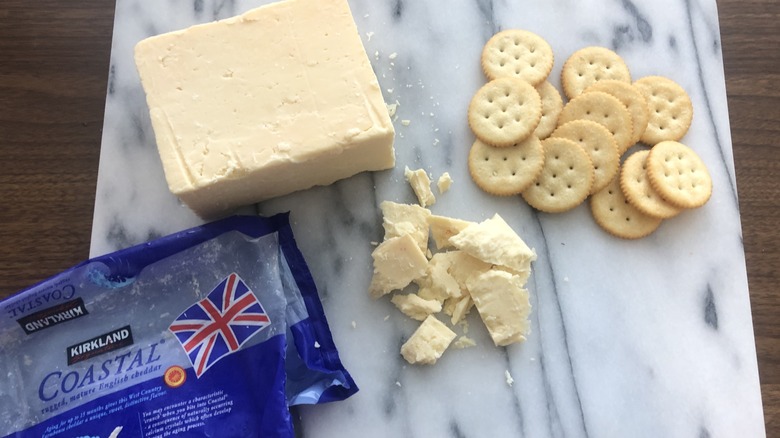
Megan Hageman / Tasting Table
Here we have a mature cheddar, compliments of England. And I think the name “Coastal” is quite fitting for this particular variety. When you go to slice it, jagged-edged pieces of cheese topple off the sturdy block just like rocks falling off a cliffside into the sea. Coastal and rugged, indeed. It doesn’t make for the most aesthetic grazing board. However, it will give your spread another classic taste that weaves in a bit more complexity and flavor depth than the Gouda or Parmigiano.
It is a smooth and inviting cheddar. I wouldn’t go so far as to label it “creamy”, though it comes close. It’s the kind of cheese that crumbles when you grab it, but then smears a bit on your fingers. It’s also riddled with calcium crystals — the same kind you would find in a Parmesan. The package explains that these can form during the cheese’s up to 15-month aging process, and I actually like the subtle crunch it adds to the product.
As far as cheddars go, it’s not the sharpest in the shed or the most robust. Instead, it’s a mild and satisfying option. It starts out the slightest bit sweet on your taste buds before turning to richer notes of umami. I could see it being a real crowd-pleaser. It’s familiar enough to cheddar lovers while also throwing in more unique components that keep adventurous cheesemongers on their toes. A strong showing for Kirkland, yet there are a few more wedges ahead that present an even higher level of quality and appeal.
4. Kirkland Signature Goat Cheese
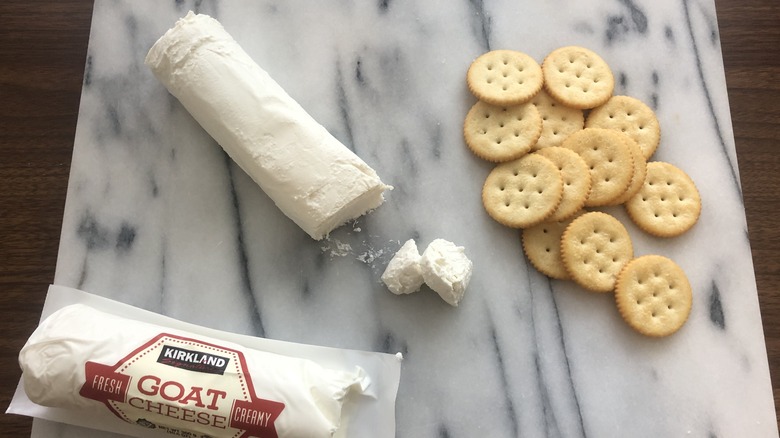
Megan Hageman / Tasting Table
This is a solid goat cheese and one of those Costco gems that should be on your regular grocery rotation. It’s one of the most budget-friendly in the taste test — I paid just $8.29 for my twin-pack (a.k.a. 21 ounces of goat cheese). And the front of the package tells you everything you need to know about its taste. It reads, “fresh” and “creamy”. Correct and correct.
Right out of the fridge, the cheese is firm enough that you can crumble it on top of a salad. At the same time, its innate velvety texture allows you to easily spread it on any surface you like, whether it’s a cracker, a piece of toast, or sandwich bread. This is that quintessential goat cheese consistency that coats your mouth in a wonderful creaminess. Aside from this, the soft cheese boasts a mild flavor yet also dabbles in a bright tartness. It’s not overly citrusy or caramel-forward as some aged goat cheeses are. It just marinates in its light tang and doesn’t overcomplicate things, sticking instead to a simple, no frills palate.
It may not be as fancy as one of Trader Joe’s beloved Chevre goat cheeses, smeared in herbs or blueberries. But it’s the perfect base to make your own, while also getting more bang for your buck. Just roll the log in a Costco bag of frozen berries or shelled pistachios, and voila, you have a foodie-approved appetizer.
3. Kirkland Signature Pecorino Romano
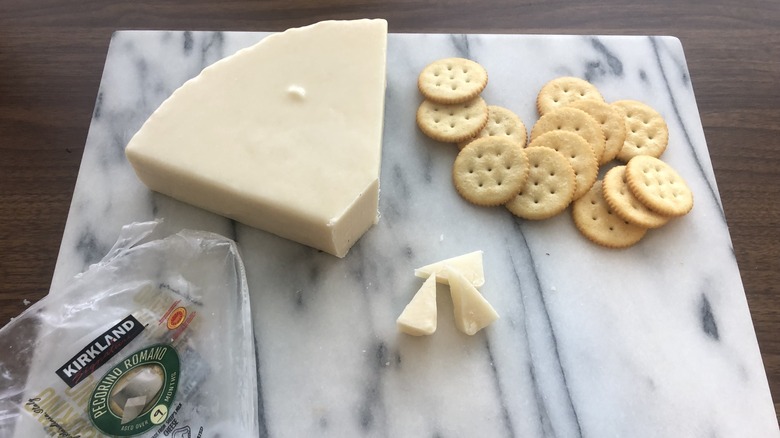
Megan Hageman / Tasting Table
In Italian, Pecorino means “of sheep”. This gives us all a not-so-subtle peek into the making of this formaggio. Then, we learn that Romano is a strong-tasting hard cheese from Italy, and that essentially sums up the entire experience. Kirkland’s version of a Pecorino Romano satisfies all these criteria. Straight from Sardinia, it’s produced from fresh sheep’s milk, which is collected from October to July for optimal quality but also in adherence to tradition. The cheese even carries the protected designation of origin stamp of authenticity. It’s the real deal.
Aged for over 9 months, this is an older Pecorino. It’s firm and crumbly rather than soft and creamy. The texture isn’t crystallized or as hard as the previous Parmigiano, but it falls into a similar category. What I particularly like about it is its potency. It’s one of the only Kirkland cheeses that gives you a little bit of funk. Alongside its deep saltiness and oily sheen, it’s this pungent earthiness that makes it stand out next to everyday choices like the Gouda, goat cheese, or cheddar.
While I don’t necessarily think I could eat wedge after wedge of this off a cheeseboard — the salt levels would start to take a toll — I think it would make for a wonderfully full-flavored Cacio e Pepe. It’s also the perfect kind of topping cheese for a bowlful of Minestrone or a white pizza. The packaging also suggests a pairing of sauvignon blanc or Chianti Classico. Don’t mind if I do.
2. Kirkland Signature Manchego
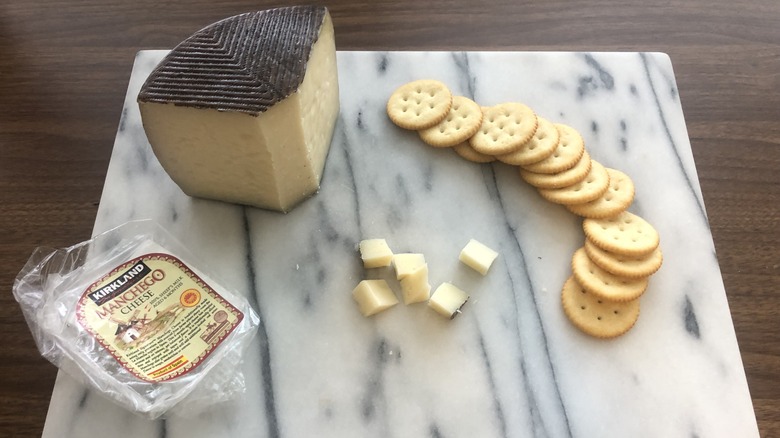
Megan Hageman / Tasting Table
Encapsulated in a mesmerizing zig-zag rind, Manchego cheese is one of a kind. I was introduced to it for the first time at a tapas restaurant in the heart of Madrid, so my taste buds are perhaps a bit biased. But I approached Kirkland’s adaptation with an open mind.
Just as all Champagne comes from the Champagne region of France, all Manchego cheese comes from the La Mancha region of Spain. It’s made with 100% sheep’s milk, and this specific hefty block was aged for a total of 6 months. Because of its rare nature and production stipulations, it does run a bit pricey, even at Costco. But trust me, it’s worth the extra coin. As a semi-smooth cheese, it slices easily like a stick of cold butter. With tiny gapes and holes throughout, it does crumble in some bites, though it’s mostly smooth and creamy in texture — fitting for a younger Manchego. Taste-wise, nuttiness is at the forefront, then it settles into more buttery notes and ends with a salty finish.
Even though it’s missing that sweet element other Manchegos offer, it’s a respectable representation. It abides by tradition and stands as a very grown-up style of cheese, yet it’s also approachable. I even like it better than the Pecorino for the simple fact that I could snack on it all day long, all by itself. Pair it with crackers, nuts, dates, chorizo, or with nothing. It doesn’t matter. It will still be delicious.
1. Kirkland Signature Sartori Bellavitano Cabernet Sauvignon
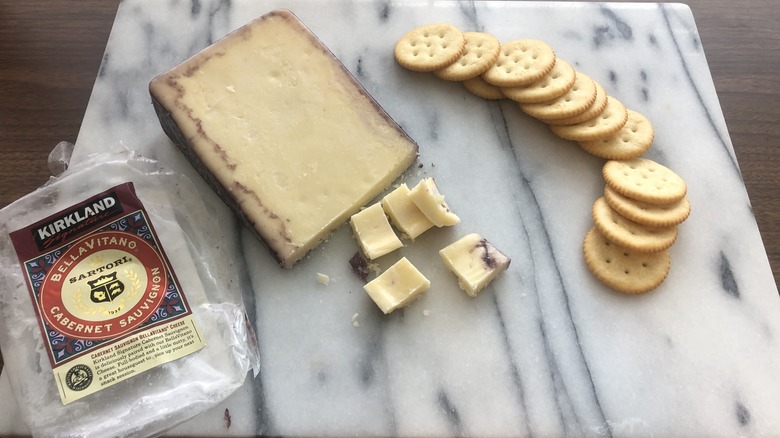
Megan Hageman / Tasting Table
Now this is a gourmet, grown-up cheese. Before we dive into its upscale taste, though, let’s break down its unique makeup. A BellaVitano is an Italian-inspired cheese — you guessed correctly. However, it was actually created by Wisconsin’s own Sartori Cheese. Profile-wise, it’s a clever fusion of cheddar and Parmesan textures and flavors. It’s also often infused with defining tastes like balsamic or tomato basil. And, at Costco, it’s enlivened by a kiss of Kirkland Signature Cabernet Sauvignon.
The purple rind and edges assure you that the red wine is present. They also play a trick on you, making you think perhaps blueberries or blackberries were involved in the making. It has the strongest bouquet of the bunch, radiating a buttery sweet aroma. In the semi-hard bite, there are some Parmesan crystals lingering. It’s more complex than a standard Parmesan, though, with fruity notes piggybacking on the existing salty and nutty ones. I would also advise you not to shy away from the rind pieces. This is where you’ll find the most richness and those familiar dark fruit cabernet tones. If you’re a fan of Kirkland wines, you know that the Cab has its own signature highlights, and they certainly show up in this cheese.
Blending two favorite cheeses into one was a genius move. Props to you BellaVitano. Two powerhouses working together are bound to create something toothsome. But it was the inclusion of Kirkland wine that really made this choice one-of-a-kind and my top pick. It’s both unique to Costco and artisanally crafted. What more could you want?
Methodology
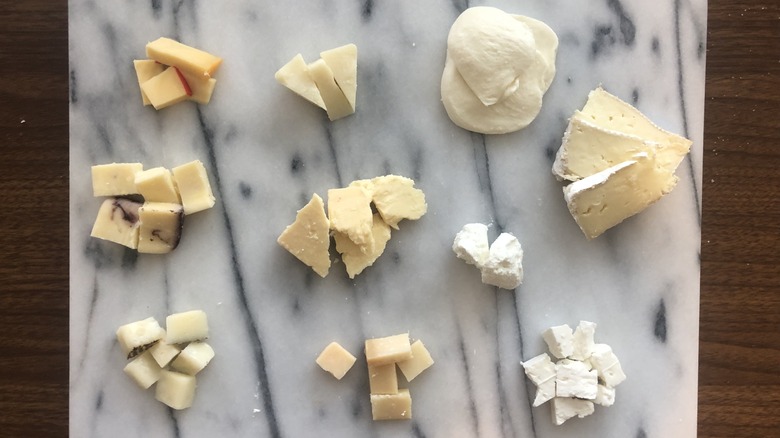
Megan Hageman / Tasting Table
Kirkland Signature is no slouch when it comes to cheese. It’s only fitting — Costco outdoes itself in nearly every category. I didn’t turn my nose up at any of the cheeses, even the stinkier ones, but some impressed more than others.
I started by looking at origin and maturation to get a sense of each cheese. I appreciated authentic flavors and cheeses that adhere to strict standards–that’s how you know you’re getting quality. Aroma and texture came next. A great cheese enlivens all the senses, not just your taste buds. I looked for cheeses that draw you in before you even slice them, and textures that linger — creamy and smooth, or, in the case of hard cheeses, those with satisfying crunchy crystals.
Lastly, and arguably most importantly, I evaluated the flavor profile. I gave favor to cheeses that are approachable and true to their category, but with a unique element that in the real world would make me ask, “Is this from a fromagerie?” But, of course, the answer is, “No, it’s Costco.”

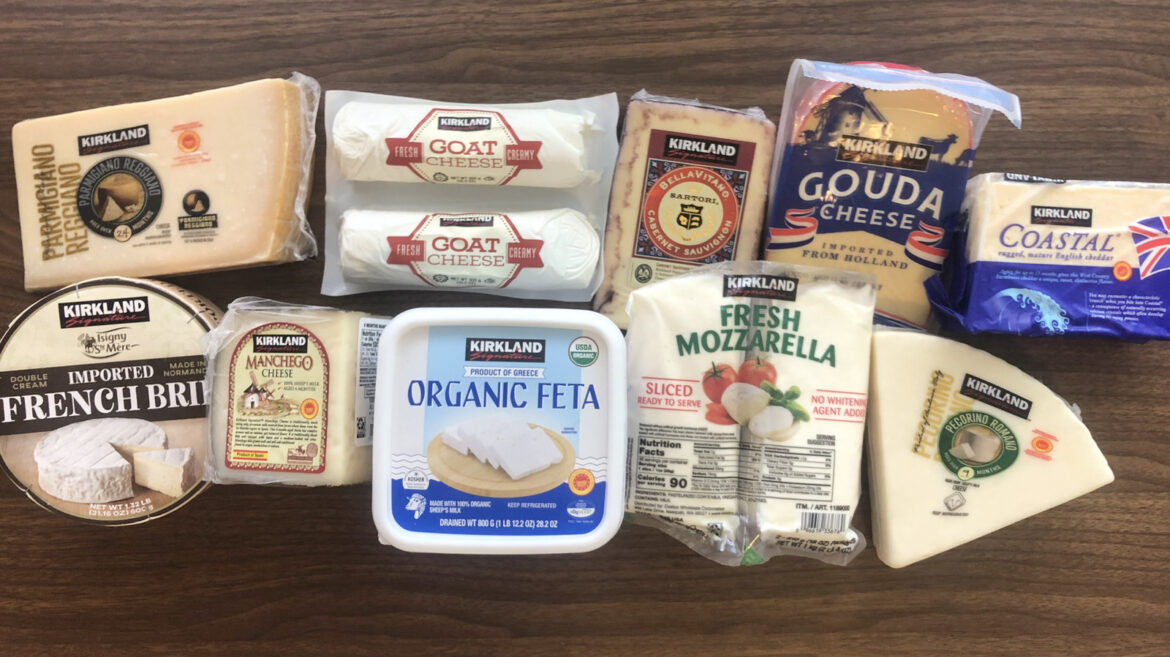
Dining and Cooking